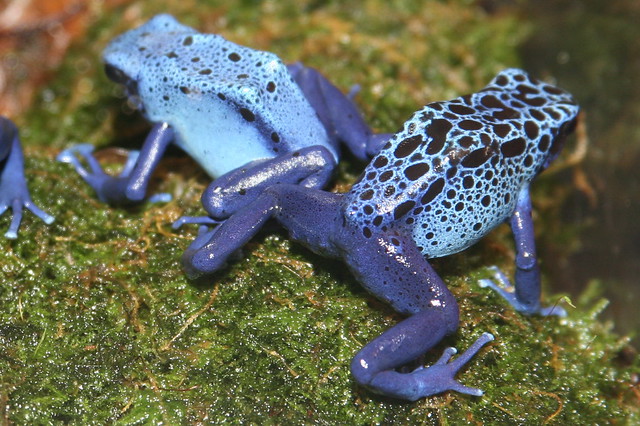 |
| Poison Dart Frog (Dendrobates auratus) (Photo credit: Wikipedia) |
Inhabiting countries of South and Central America like Costa Rica, Columbia, Bolivia and Peru, the poison dart frog is a stunning, bright colored frog that secretes a poisonous toxin. The science community only discovered this unique frog in the 1960's, but it has been known by tribes for many years. By the name of the frog, one might think that it is somehow able to shoot poisonous darts, but this is simply not the case. The poison dart naming comes from the fact that tribes in the rainforest used the poison on the tips of darts that they would use to subdue a threat.
The poison dart frog is not just one frog, but an entire species of frogs that contains well over 100 individual types of poison dart frogs. Usually, these frogs are quite small and measure less than 1 inch long, but some species can grow up to about 2.5 inches.
While the poison in many species of poison dart frogs may not be enough to kill a healthy human, there have been instances where the poison entered a cut or scratch which resulted in death. Their poison is quite effective in subduing their predators, however, if a poison dart frog is born in captivity, it's unlikely that they will contain any poison. The poison that is developed in the frog while out in the wild is because of it's diet of ants, termites, beetles and other insects. When they no longer eat the poisonous beetles of Central America, the toxins in their body are no longer produced, making them harmless.
Most of us are accustomed to seeing frogs at the edge of a pond, marsh or stream, but the dart frog is different. It does not have webbed feet and is therefore not a good swimmer so you won't find one of these frogs living in ponds.
Unfortunately, the Poison Dart frog is experiencing a population crisis and is on the endangered species list. Over the years, destruction of rainforest land as well as droughts in their regions, these frogs have decreased in numbers. Fortunately, pet Poison Dart Frogs are bred only in captivity and are not collected from the wild.
The bright colors of these frogs are just incredible and it's no wonder why people want to keep them as pets. With proper care, the Poison Dart Frog can live for many years in captivity.
|

